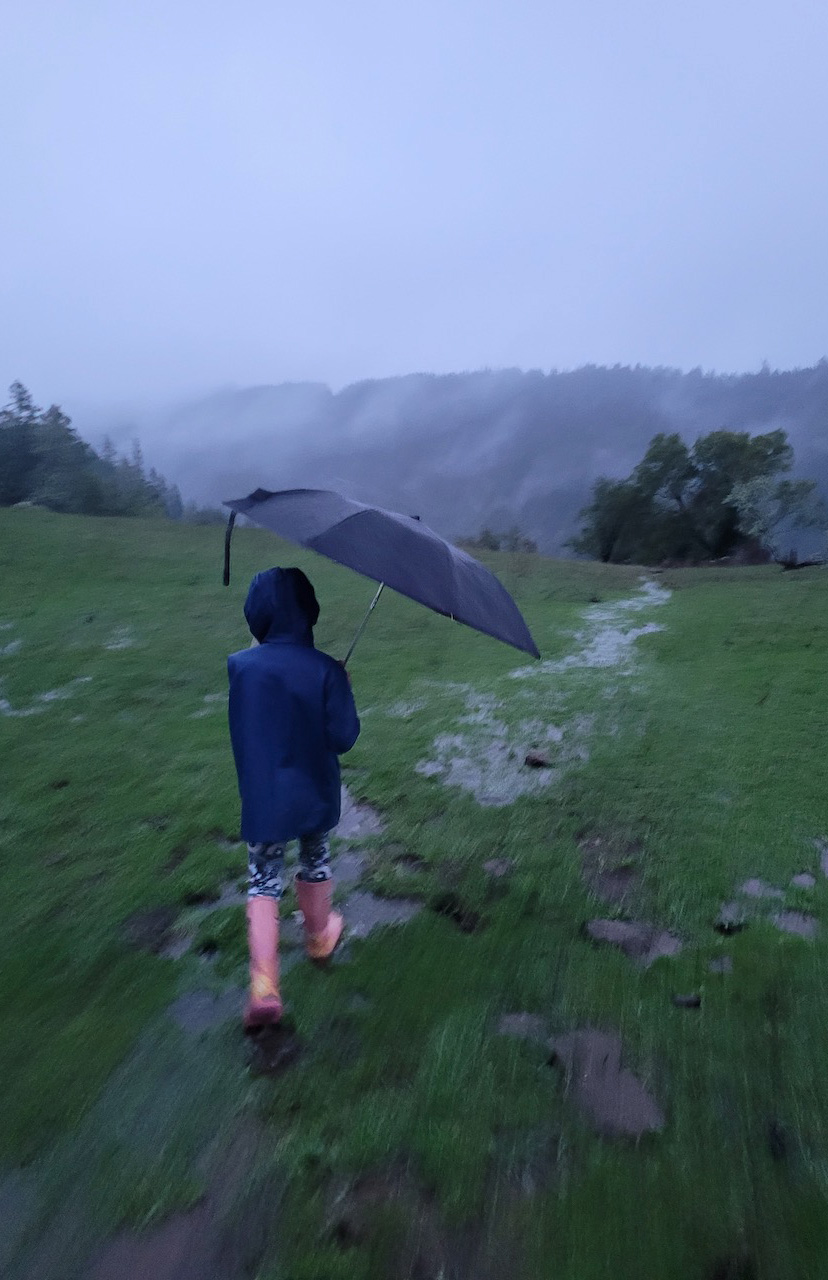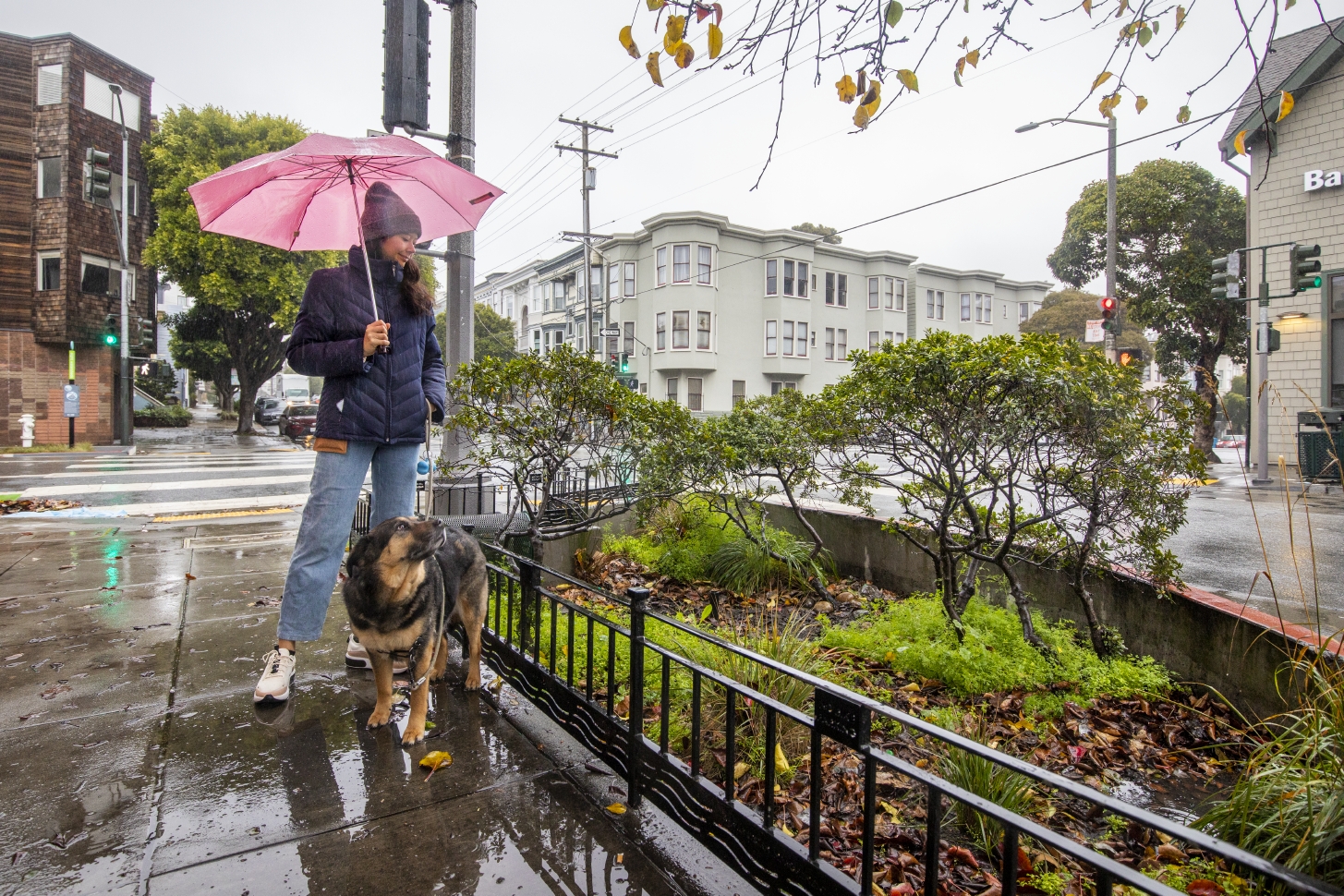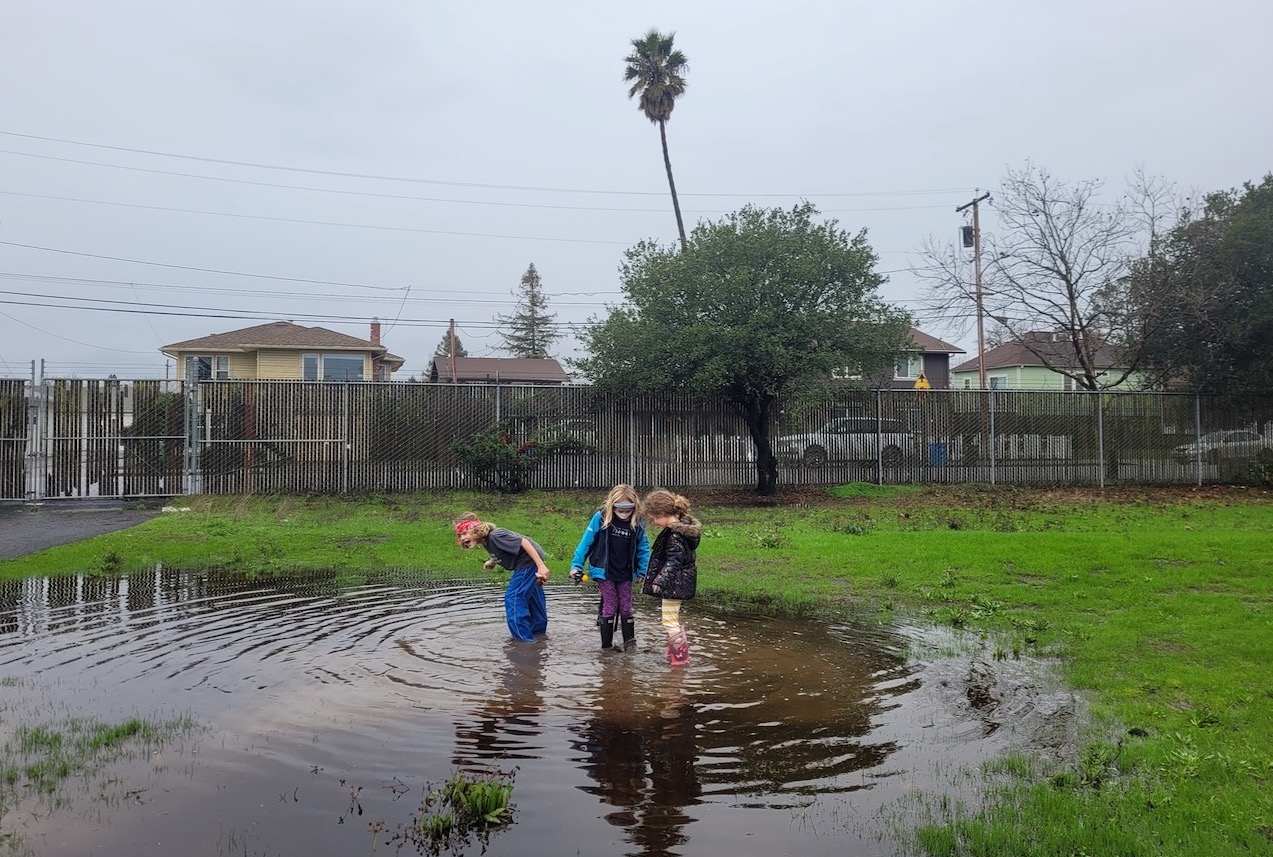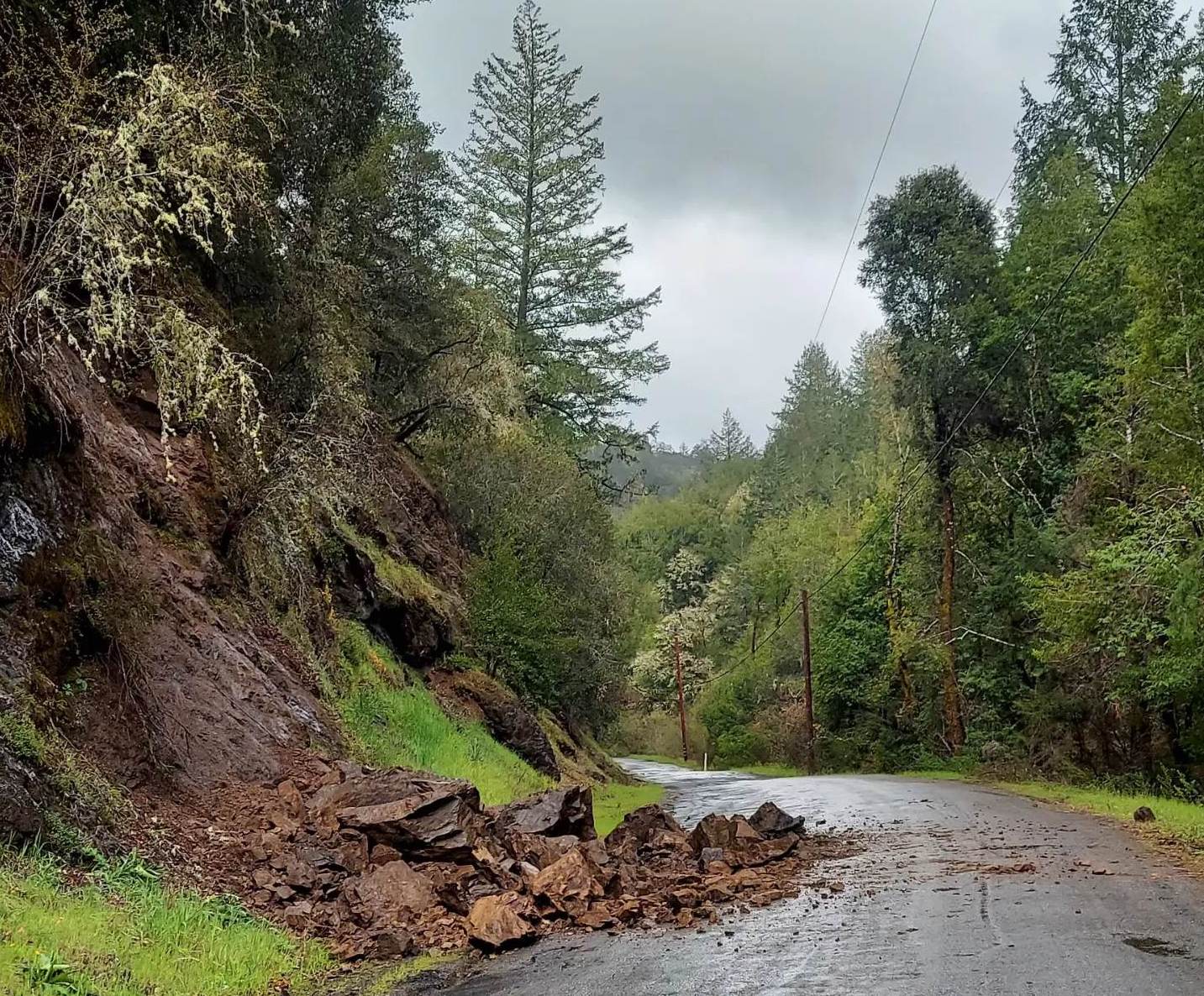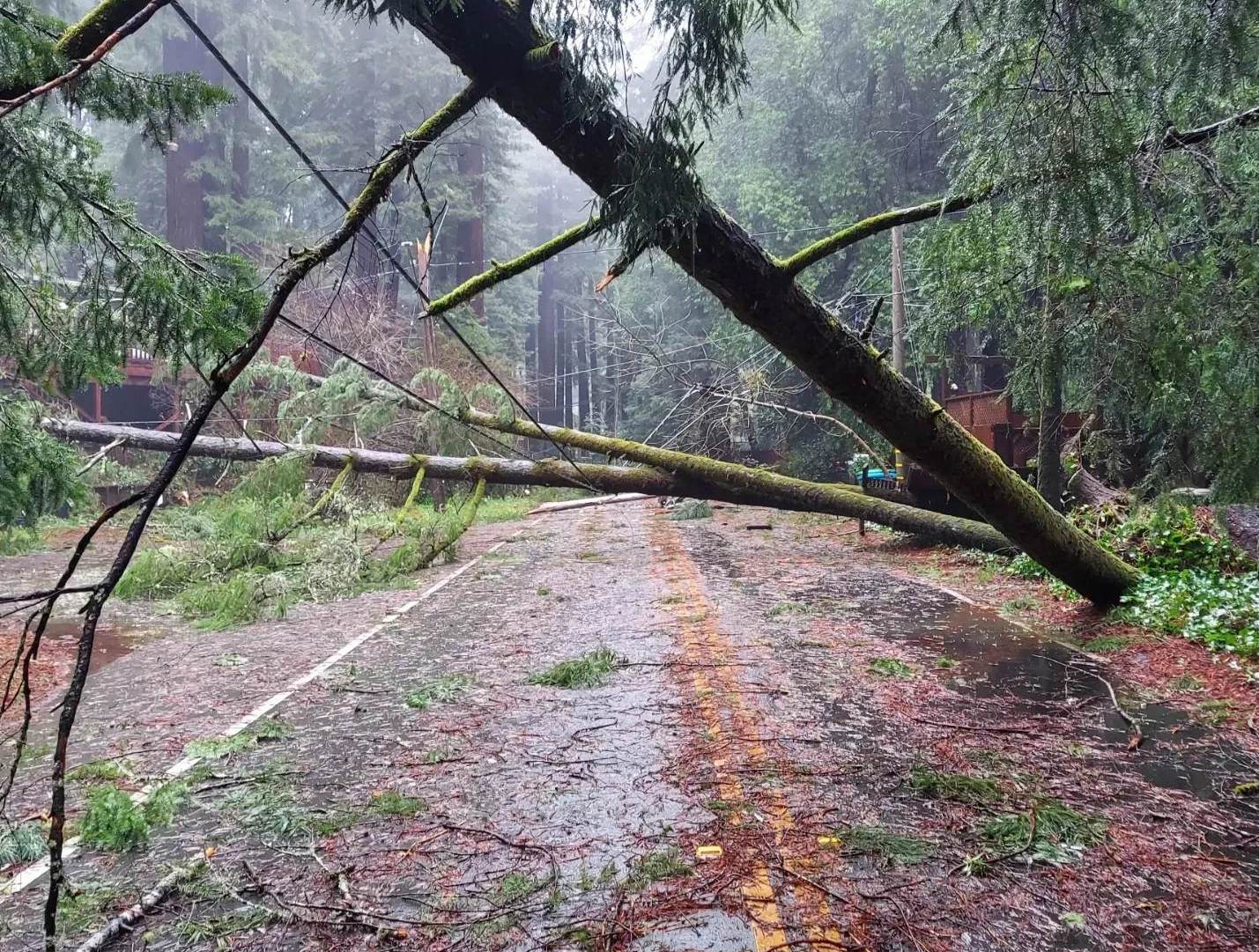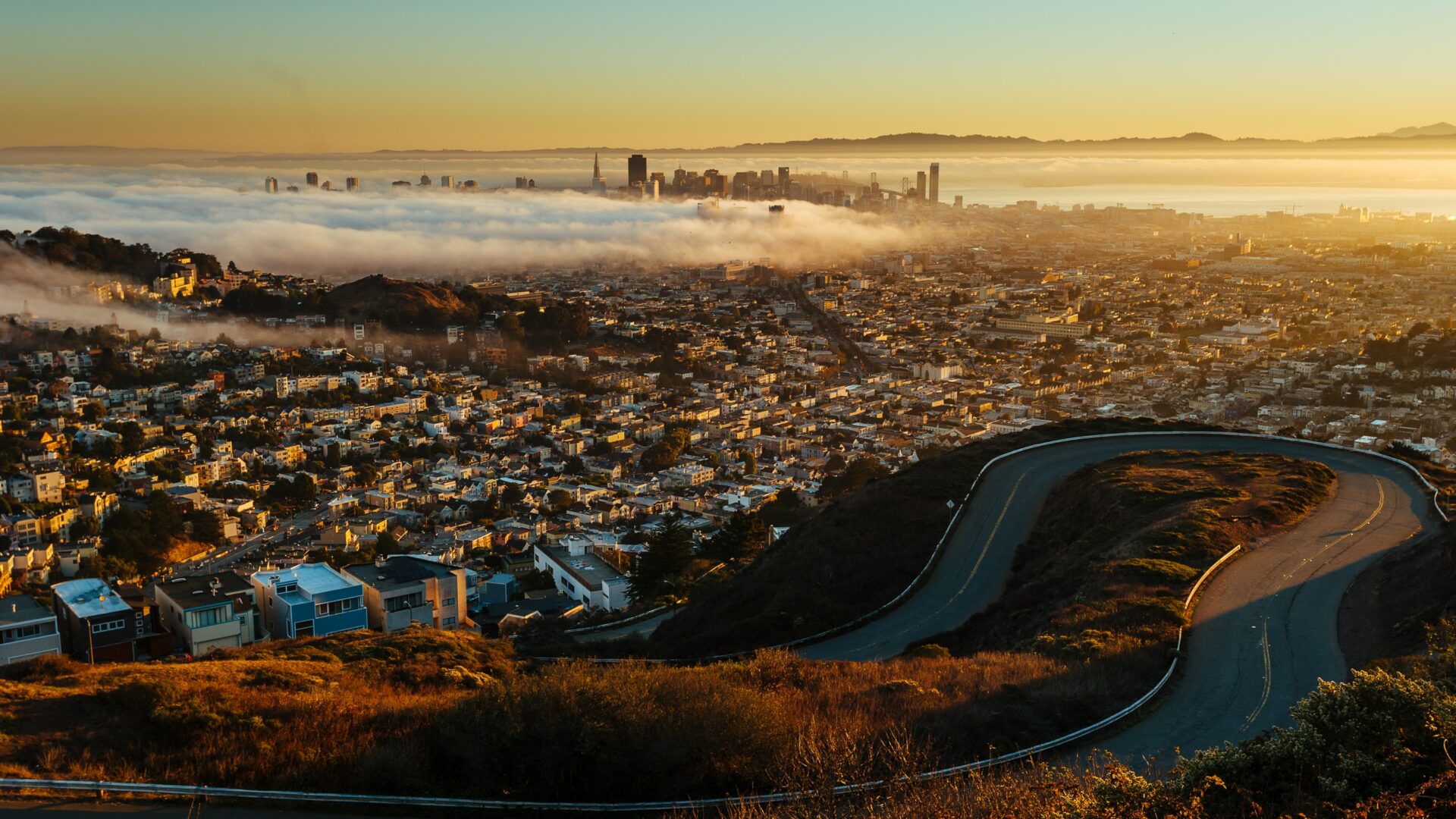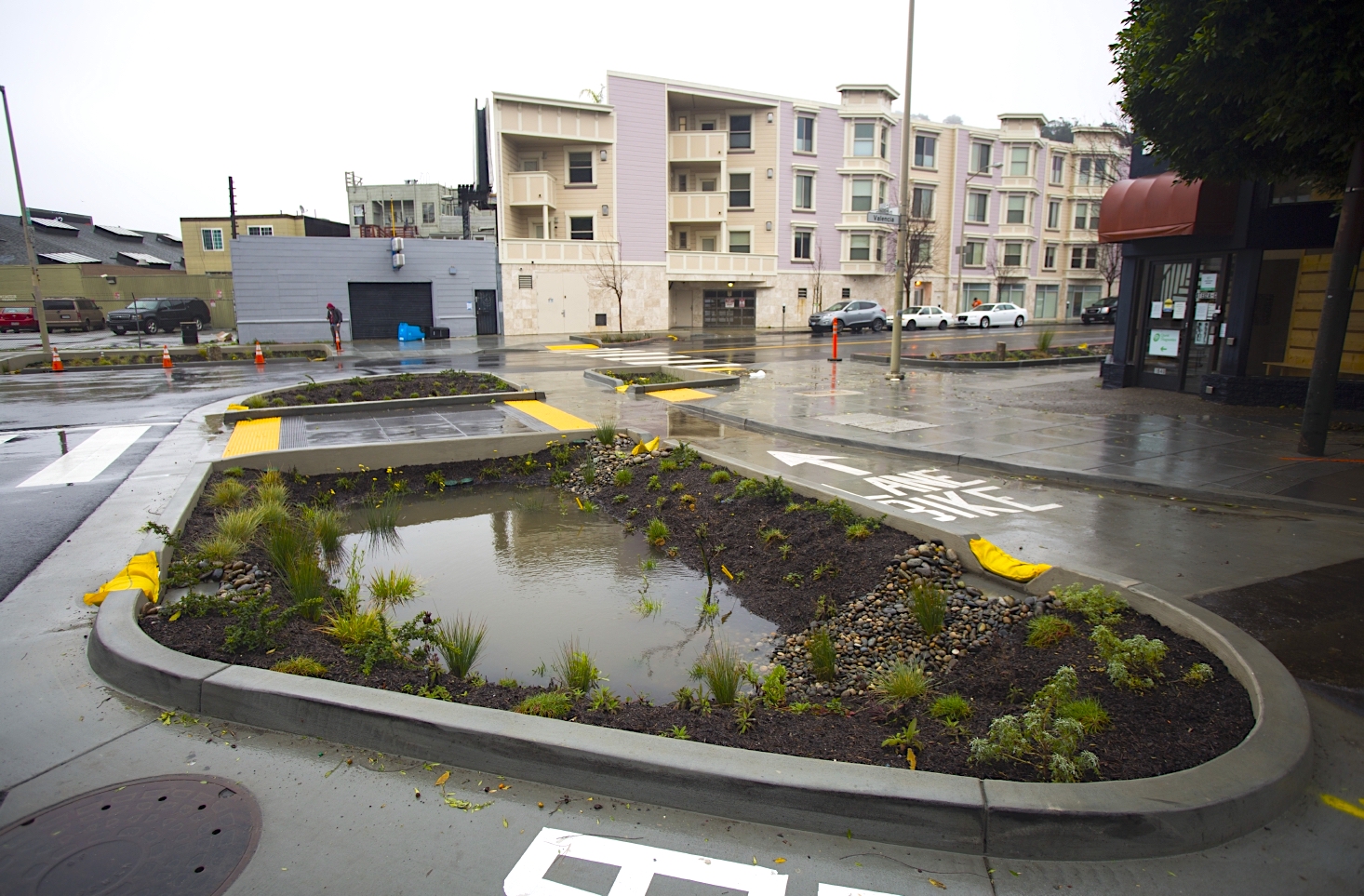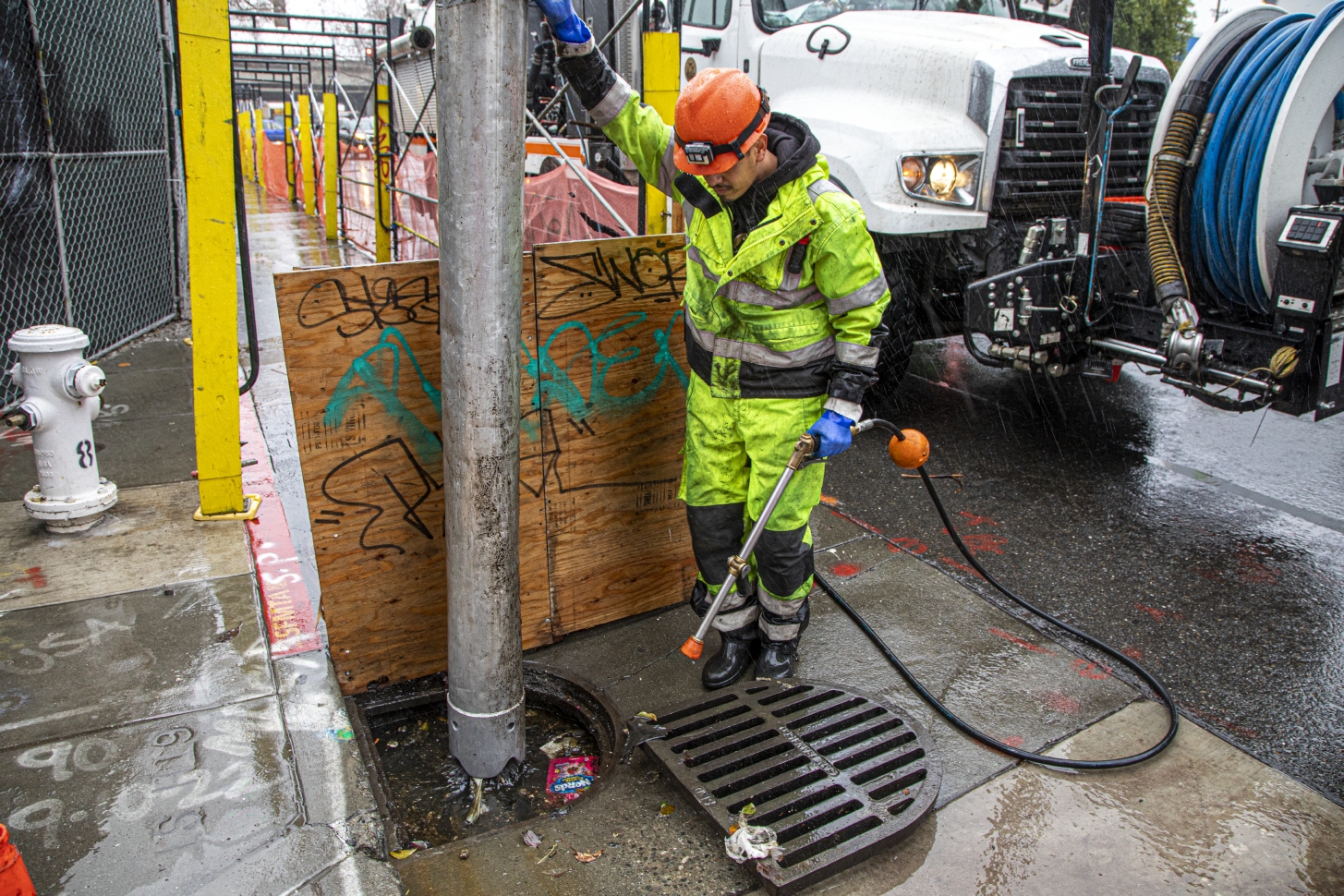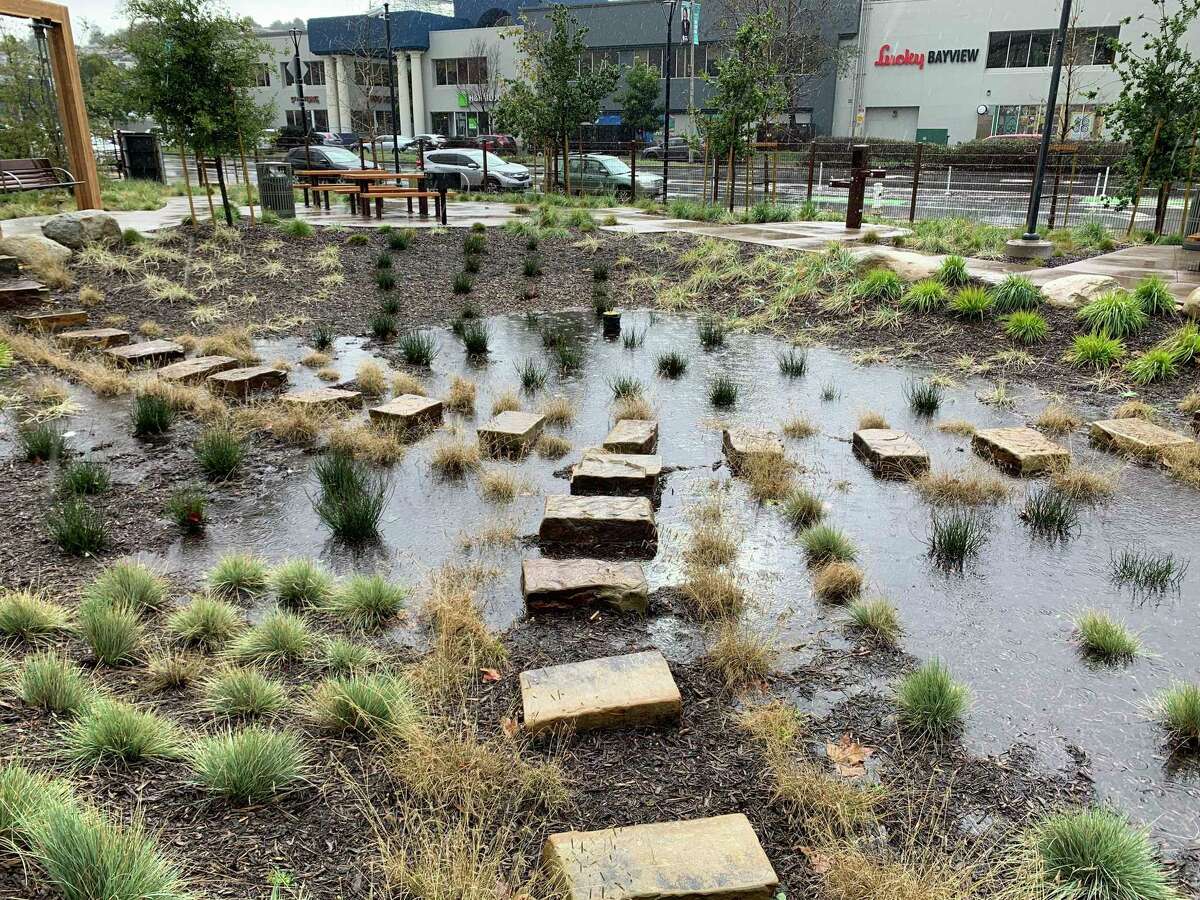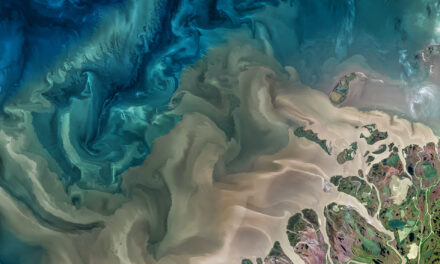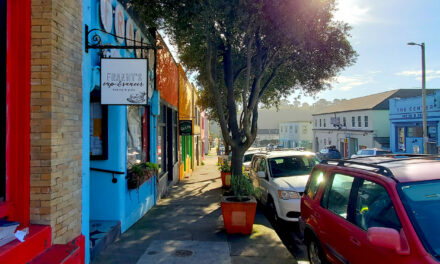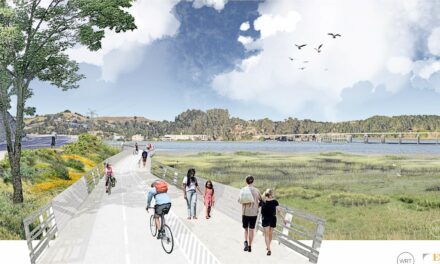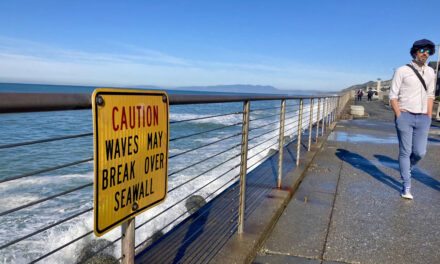Photo: Jacoba Charles.
Being Human in Big Weather
When it rained this May, it felt unexpected. Of course, it didn’t rain nearly as much as earlier in the year, when my daughter and I spent hours exploring the ephemeral new streams that sprang up, rushing and gurgling through the hills of our family property in northern Sonoma County near Timber Cove. Based on over 150 years of climate data for San Francisco, which can roughly be extrapolated out to the Bay Area in general, May typically gets several days with a light rain. And although this winter was undeniably wet—with 34 inches of rain, it ranked 14th out of the last 150 years of San Francisco-based records, according to meteorologist Jan Null of San Jose State University—it was very average when it came to the number of wet days. But context is key, and we are coming out of three years of drought—a fact which will generally color memories in a drier hue. “If I’ve learned anything it is that people’s perceptions are usually wrong,” says Null. “Without looking at the data, we all kind of remember, you know, the last couple of years.” Regardless of how our climate anxiety stacks up against the climate record, this winter’s storms showed us just how people in both rural and urban communities are absorbing the shock and preparing for more.
Extremes-in-3D
A five-part series of stories in which KneeDeep Times explores the science behind climate extremes in California, and how people and places react and adapt.
Supported by the CO2 Foundation and Pulitzer Center.
FULL READ
Being Human in Big Weather
In early May, a small storm interjected several overcast days and occasional rain into long-awaited spring weather. In front of my daughter’s second-grade classroom, one mom wrapped her jacket around her and complained, “not again!” while another replied, “I thought we were done with this!”—sentiments echoed often after a cold, wet winter that felt very long.
However, human perception can be a fickle thing; rain in May only feels unexpected. Based on over 150 years of climate data for San Francisco—which can roughly be extrapolated out to the Bay Area in general—May typically gets several days with a light rain.
And although this winter was undeniably wet—with 34 inches of rain, it ranked 14th out of the last 150 years of San Francisco-based records, according to meteorologist Jan Null of San Jose State University—it was about average when it came to the number of rainy days. To date this year we have seen 76 days of rain: just slightly above the average of 71 days based on those same 150-year records. But context is key. We are coming out of three years of drought—a fact which will generally color memories in a drier hue.
“If I’ve learned anything it is that people’s perceptions are usually wrong,” says Null, who has studied that long record extensively. “Without looking at the data, we all kind of remember, you know, the last couple of years.”
EXTREMES-IN-3D
A five-part series of stories in which KneeDeep Times explores the science behind climate extremes in California, and how people and places react and adapt.
Series Home
Click here to enter
Supported by the CO2 Foundation and Pulitzer Center.
In actuality, we only have to go back a few years to see numbers similar to this past winter — both 2017 and 2018 beat this year for the total number of rainy days. In fact, the 2017 rainy season chocked up 32.34 inches of rain, squeaking in by a hair behind this year in quantity.
“This year we had a lot of big rainy days—where we got more than two inches of rain. Back on New Years Eve we had five inches of rain in one day. So that creates another perception; people think ‘this must be the rainiest year’—and that’s just not true,” says Null.
Battling Climate Anxiety
On the flip side of the rain-perception experience are those—myself included—who rejoice in each downpour. No matter how much we get, I am happy to see more. When we woke to the latest rain, my eight year old pulled on her boots and invited me to eat breakfast with her outside; we listened to the rain drip from the oak trees and didn’t mind the dampening of our hair and Cheerios.
But my joy goes deeper than my basic predisposition toward petrichor. As a botanist and a gardener, I am intensely aware of the impacts of long-term drought on our beloved natural landscape—and knowing that such droughts (and related effects like water shortage and fire) are expected to become increasingly common sparks deep dread in my heart.
In other words, I now see weather through a lens of what has come to be called “climate anxiety”—and I am far from alone. A 2022 Yale survey found that 64% of Americans are worried about climate change; many used the words disgusted, sad, and afraid. And Google searches for climate anxiety went up by 565% between 2020 and 2021, according to data obtained by Grist. Therapists now regularly treat clients for this particular kind of anxiety.
Three kids in Petaluma make the most of a meadow puddle. Photo: Jacoba Charles.
“Not a day goes by where I don’t think about our climate, and about our kids’ future,” says Anna Coopersmith, a hand therapist in Petaluma who compulsively checks the weather forecast. She says the years of drought and fire have not only impacted her mental health, but have led her to consider moving.
“This year has been better. I feel like I’ve been able to let go of some of my fear because of the rain we had,” Coopersmith says.
Even as each individual’s reaction to the winter is a unique cocktail blended from experience, personality, and perception, there is no question that the quantity of rain created a suite of tangible effects on daily lives and infrastructure. Impacts ranged from large scale disruptions such as detours, evacuations, and power outages, to personal hassles like leaking roofs or eroded landscaping.
Location, location, location—as it is with so much else—was key to how community were affected. Those living in the floodplain of the Russian River spent much of the winter on tenterhooks; in the small north bay city where I live, life was mainly undisrupted.
Photo: Norm Green.
Marooned in Backwoods Sonoma
While much of the Bay Area is occupied by closely connected cities and towns, the coastal range of northern Sonoma County is remote and sparsely populated. Narrow roads twist through steep terrain, and services—whether gas pumps or health centers—are often few and far between. While comparatively few people live out in these hills, a much higher percentage of the population had their daily lives disrupted by the veritable railroad train of storms that chugged one after another through the region.
Those who live near waterways monitored flood warnings that changed by the hour. Roofs leaked, basements flooded, power went out. Rain-loosened earth slid across roadways and upended trees. Storms tossed branches onto vehicles and homes.
The impact of fallen trees—and power lines—was “tremendous,” according to Erich Lynn, chief of the rural Timber Cove Fire Protection District.
“We saw more trees down across roads in this one winter than in the last several years combined,” Lynn says. “After the drought, the forests just weren’t prepared for a normal winter—so that really hit us hard.”
Upended trees during the 2022-2023 rainy season in Northern Sonoma. Photo: Norm Green.
He estimates that over 1,000 trees came down in one 20-mile stretch of Highway 1 alone, as saturated soils became too soft to hold them upright. Countless more fell across the smaller roads, public and private, that wind inland from the coast. In a cascading series of effects, the fire department then fielded increased medical calls, as individuals were injured while attempting tree removal.
“CalTrans was all over the highway keeping it open,” Lynn says. “Roads were closed for a day or two at the most.”
Along with the trees, power lines also toppled—knocking out power for as long as five days. Internet and long-distance landline service were also lost along with the electricity. To make matters worse, the region generally lacks cell signal.
“People couldn’t call out, but we get cell service here at the fire station, so we had a volunteer here with a cell phone so they could call out with emergencies,” Lynn says, noting that volunteers staffed the station 24 hours a day.
“We really just encouraged people to stay home,” Lynn adds.
Awash in San Francisco’s Streets
Seventy miles to the south, the same winter storms unleashed their wind and water onto a very different landscape. If you zoom out to a landscape level view, San Francisco unrolls like a tapestry draped across a grouping of seven steep hills. When heavy rain falls, it flows swiftly downhill a flow that is hastened because this urban tapestry is made virtually entirely of concrete, pavement, and other impermeable surfaces.
This confluence of topography and development leads to an engineering challenge in big storms like those we saw this winter. When an atmospheric river opens its spigot, water runs from roofs and sidewalks into gutters and storm drains, at times faster than it can be accommodated. When garbage or natural debris like leaves or tree limbs block drains and other outlets, the rain pools, forming puddles or even lakes that urban pedestrians are ill-equipped to wade through.
“This winter’s atmospheric rivers really underscored what we need to prepare for, and what we’re going to see more of in the future,” says Sarah Minick, Utility Planning Manager at San Francisco Public Utilities Commission (SFPUC).
Minick explains that the city’s water system was designed for a level of storm severity called a “five year” storm, meaning that such a storm would be expected to occur once every five years. However, several of this winter’s storms were 100-year severity level — well beyond what they city’s system was designed to handle.
“The system performed well, given what it was designed for,” Minick says. “If San Francisco didn’t have its amazing combined sewer system and its gravity fed engineering, the flooding would have been much, much, much, much worse.”
Rain falls in gardens designed to absorb stormwater rather than add it to the sewer system. Mission & Valencia Streets in San Francisco. Photo: SFPUC.
Yet despite that, water still crept into peoples’ lives. It poured down sloping driveways into garages built decades ago, below street level. Soil loosened and trees fell. During the New Year’s Eve storm, water pooled in topographical bowls—such as the intersection of Folsom and 17th Street, which once was a navigable waterway, according to Joseph Sweiss, SFPUC spokesperson.
“Part of the reason for the flooding witnessed was the historic intensity and duration,” Sweiss says. “The amount of rain that fell in that timeframe is far greater than the capacity of any urban stormwater system.”
In the first few very wet weeks of January, San Francisco as a whole received more than 3,600 storm-related service requests, including 1,200 requests for tree maintenance, according to Sweiss; the SFPUC fielded nearly 1,600 of those requests. “Our crews work around the clock, and overtime, to address these requests quickly and monitor for more,” Sweiss says.
SFPUC’s storm response crews vacuum out debris using giant (Vac-con) trucks at the corner of 6th Street and Clara Street in San Francisco. Photo: SFPUC
While infrastructure is always being improved, Sweiss emphasizes that the city is encouraging property owners to add another layer of protection and take advantage of SFPUC grants of up to $100,000 to make their properties flood resilient. Residents are also stepping up through volunteerism—of the city’s 25,000 storm drains, over 6,000 are monitored by individuals through the City’s Adopt-A-Drain program. Over 2,460 of those drains were adopted in the first few months of this year.
For over a decade, another avenue that San Francisco has been pursuing to boost the storm water system is developing a green infrastructure aspect to its flood resilience.
“We have to recognize that some storms are not going to fit in traditional underground infrastructure—and so we are going to have to change our thinking about how we build cities and get them ready for climate change,” says Minick.
In one project, the SFPUC is constructing one green infrastructure project in each of the city’s eight watersheds; examples include a green alley in Chinatown; the daylighting of Yosemite Creek in McLaren Park; and over 80 streetside rain gardens of various sizes, including plazas and terraces. All are designed to capture rain and reduce the risk of flooding, as well as to have additional benefits for the public such as recreation and aesthetics.
Green infrastructure at the SFPUC’s Southeast Community Center demonstrates the integration of stormwater management, flood resilience, community spaces, and beauty into an urban setting. Photo: SFPUC. Also shown in banner video.
Moving forward, the City will continue expanding green infrastructure where possible, Minick says.
“The city is built out, and it looks very static to a person who is just walking around. But if you think about it, the parcels are very dynamic over decades,” Minick explains. “One way to get more green infrastructure into San Francisco is to require it as part of new development.”
There remains the question not only of the where, but the what.
“Hopefully we will find a way to explore larger nature-based solutions,” Minick says, explaining that the city is considering storm-absorbing facilities that meet a variety of goals. “Atmospheric rivers are obviously super important and impactful—but what will that facility be contributing when it is not wet out?”
“Hopefully, it will also be increasing resilience to extreme heat,” Minick says. “It could be wildlife habitat, and also offer recreation. Hopefully, it will be beautiful and make people feel good about living in this city. There are lots of exciting challenges.”
More
- Preparing Yourself for Climate Crises
- Green Infrastructure Grants for San Francisco
- Floodwater Management Grants for San Francisco Public Utilities Commission
- Getting Rain Ready – Resources & Tips
KneeDeep does not endorse these products.
EXTREMES-IN-3D
SERIES CREDITS
Managing Editor: Ariel Rubissow Okamoto
Web Story Design: Vanessa Lee & Tony Hale
Science advisors: Alexander Gershunov, Patrick Barnard, Richelle Tanner
Series supported by the CO2 Foundation.
Special thanks for Being Human in Big Weather
Top video of green infrastructure at the SFPUC’s Southeast Community Center courtesy San Francisco Public Works.






